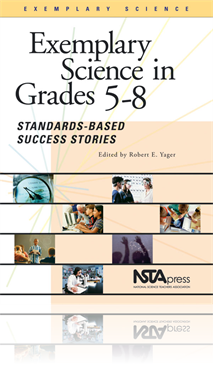All Book Chapters
Book Chapter
Teaching Science With Pictures
The state of Texas is divided into 20 Regional Education Service Centers (ESC). Schools located in three of the independent school districts of the largest region—Region IV ESC—were selected as pilot sites for a program designed to increase stude...
Book Chapter
Finding Out What...and How They Know
The setting for this chapter is Hawkins Middle School located in a small rural city, the county seat of one of the poorest counties in Wisconsin. In this project students engaged in a learning experience that was integrated across subject areas and f...
Book Chapter
The reader may question how the "Teach them to fish" proverb relates to science education. Yet, a shift in emphasis from presenting knowledge through lecture and demonstration to encouraging active learning, in which students learn with understanding...
Book Chapter
Creating a Classroom Culture of Scientific Practices
Scientific practices are the activities that scientists engage in as they investigate the natural world. These daily practices include asking questions, designing investigations, finding, incorporating, and using information, collecting and organizin...
Book Chapter
More Emphasis on Scientific Explanation: Developing Conceptual Understanding and Science Literacy
This chapter describes a process for engaging middle school students in writing scientific explanations in the context of project-based science. In four Detroit classrooms, teachers enacted strategies for explanation writing that aimed to help studen...
Book Chapter
Traveling the Inquiry Continuum: Learning Through Teacher Action Research
This chapter addresses the More Emphasis on Teaching and the Content and Inquiry Standards from the National Science Education Standards (NSES). Using the knowledge gained through the Community of Excellence in Mathematics and Science (CEMS) program,...
Book Chapter
Modeling: Naturally Selecting an Effective Teaching Method
This chapter examines middle school level curriculum for evolution which incorporates many aspects of the More Emphasis conditions from the National Science Education Standards (NSES). Taking into account that in order to teach evolution successfully...
Book Chapter
Teaching English Through Science and Science Through English
What better way to learn English than through the study of science, and what better way to learn about science than experiencing it through language and literacy in and out of the classroom. Sutman, Allen, and Shoemaker (1986) observed in Learning E...
Book Chapter
Perspectives on Teaching and Integrating English as a Second Language and Science
In the chapter, the authors briefly review the evolution of ESL instruction and science education. They discuss current promising practices that integrate ESL, literacy, and science. Finally, they highlight innovative programs in schools that offer i...
Book Chapter
Learners, Programs, and Teaching Practices
The changing demographics of the United States and recent focus on educational standards have made it increasingly critical to address the needs of the many linguistically and culturally diverse students in our schools. Schools throughout the United ...
Book Chapter
Planning Science and English Instruction: One Teacher's Experience
The authors of this chapter describe how to incorporate science, language arts, and ESL standards into the classroom. They offer practical suggestions on how to plan, organize, and implement activities based upon standards, teaching and learning stra...
Book Chapter
Strategies for Teaching Science to English Learners
Teachers who teach science play a key role with English language learners (ELLs). In this chapter, the authors discuss strategies teachers can use to help English language learners learn science while improving their speaking, listening, reading, an...
Book Chapter
Strategies for Assessing Science and Language Learning
In this chapter, the authors give an overview of principles for assessing language learners in science. They describe how to plan assessment, how to use it in the classroom, and how to provide feedback and improve learning, ...
Book Chapter
Science Beyond Classroom Walls: Fairs, Family Nights, Museums, and the Internet
A field trip is only one example of how valuable connections between formal and informal education settings are for the teaching and learning of science. In this chapter, the authors provide ideas on expanding learning beyond the classroom. They desc...
Book Chapter
Designing Lessons: Inquiry Approach to Science Using the SIOP Model
Using the Sheltered Instructional Operation Protocol (SIOP) Model, the authors in this chapter discuss science inquiry, the SIOP Model, and how to blend the two for good science instruction. They finish the chapter with a conversation between a scien...



